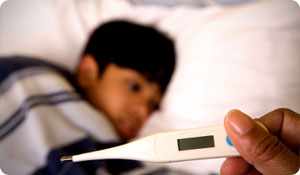
The next time your child has a fever, there's no need to get heated up with concern. The experts say that an elevated temperature in a healthy child is usually nothing to worry about; it's simply the body's way of fighting off germs.
Fever Facts
Although most fevers aren't cause for you to lose your cool, when your child feels warm, you'll want to take her temperature to monitor the situation and know when it's time to call the doctor. Sometimes a fever can indicate an infection that needs medical attention, so you'll want to stay on top of it.
Types of Thermometers
There're several different thermometer types you can choose to take your child's temperature, but a few of the popular options used today are standard digital thermometers and digital ear thermometers. Standard digital thermometers can be placed in the mouth, under the arm or in the rectum in order to measure the body temperature. These work using electronic heat sensors and usually gives a reading in about 30 seconds. Digital ear thermometers, on the other hand, measure the temperature inside the ear by using an infrared ray and these typically take only a few seconds for the results to register.
Taking Your Child's Temperature
Which type of thermometer you select, and how you use it, can often depend on your child's age. Please review the following suggestions to help guide you through taking your child's temperature properly.
Newborns: When taking a newborn or infant's temperature, pediatricians recommend using a standard digital thermometer rectally. First you should lie your baby face down and spread her legs a bit. Then you can use petroleum jelly on the tip and gently ease it into the rectum about a half-inch to one inch. (Be careful not to insert too far. You just want to insert it in far enough for the tip to disappear.) Plan to hold it in place until it beeps to signal that the reading is complete. Also be aware that when you remove it, you may find that the motion prompts her to go to have a bowel movement, so you'll want to be prepared.
Babies and Toddlers: Once your baby is three months old, its okay to graduate to placing the digital thermometer under the armpit instead. Place it snugly against dry skin. Or, you can opt for a digital ear thermometer, which should be inserted into the ear canal. Be sure that it goes in far enough to get an accurate reading. In either case, hold the thermometer in place until you hear that telltale beep.
Children and Tweens: Once your child is about four years old or beyond, you may want to try using a standard digital thermometer under her tongue. In order to get the most accurate reading, make sure she keeps her lips lightly closed around it. Then leave the thermometer in place until the beep sounds. If your child has been outdoors or has recently had anything to eat or drink, you should wait about 20 minutes before taking her temperature, since these factors can affect the results. Further, if your child doesn't feel up to doing an under-the-tongue reading, you can also always use an under-the-arm or ear technique instead.
Variations in Readings
It's important to keep in mind that depending on the technique you choose, there's a wide variation in how accurate the temperature reading will be. Rectal and oral readings can often be the most reliable. Therefore, if you call your pediatrician to get advice on how to treat your child's fever, she'll likely want to know what method you used to measure it. Also, when in doubt about the reading, you may want to repeat it a few times and see if you get consistent results.
Sources:
KidsHealth.org/Nemours
http://kidshealth.org/parent/general/body/fever.html
The Mayo Clinic
http://www.mayoclinic.com/health/thermometer/HQ01481





